Preventing preventable diseases: a 12-slide primer on foodborne disease
0 likes50 views
Presentation by Hung Nguyen and Arshnee Moodley (ILRI), Nairobi, November 2023
1 of 13
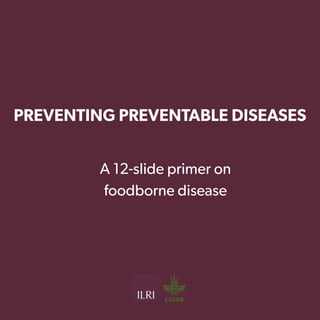

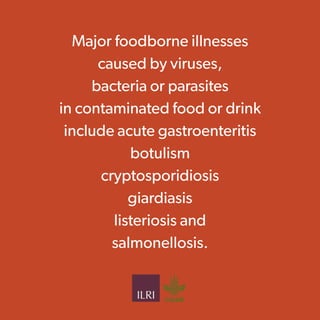

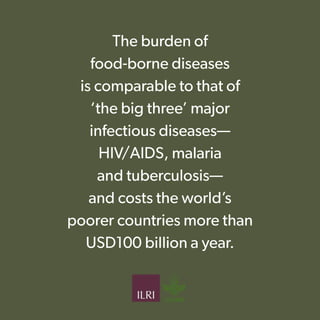

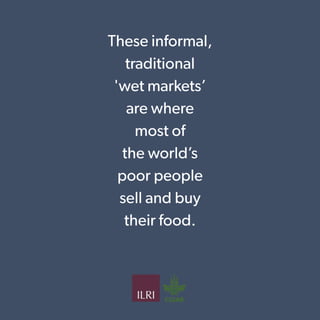
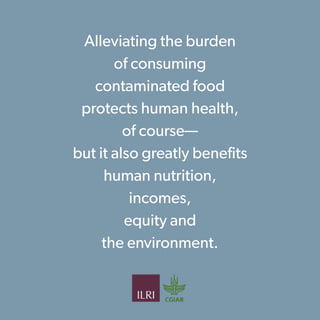
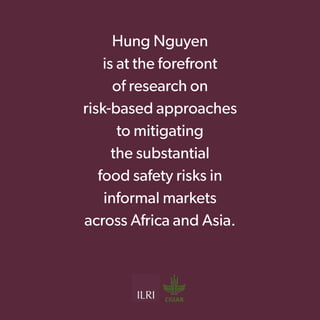

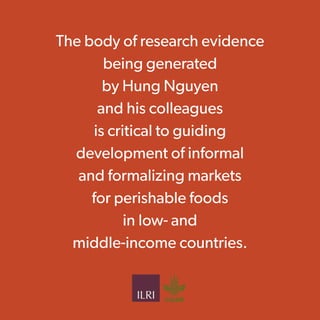
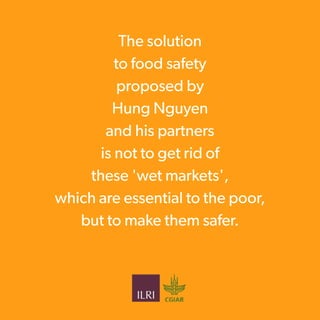
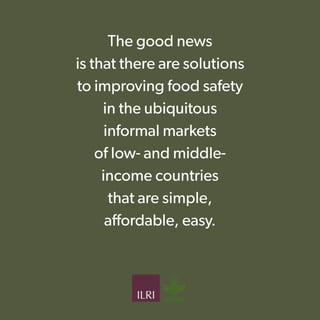
Ad
Recommended
How the small-scale low biosecurity sector could be transformed into a more b...
How the small-scale low biosecurity sector could be transformed into a more b...ILRI
╠²
The document discusses transforming small-scale low biosecurity livestock systems in Uganda into more sustainable and biosecure practices, particularly focusing on pig farming. It highlights the challenges posed by African swine fever, the importance of education and capacity building, and successful interventions through participatory training and digital communication methods. The findings suggest that improved biosecurity measures and market systems can enhance farmer incomes and livelihoods while addressing food demand growth in low and middle-income countries.Small ruminant keepersÔÇÖ knowledge, attitudes and practices towards peste des ...
Small ruminant keepersÔÇÖ knowledge, attitudes and practices towards peste des ...ILRI
╠²
The document discusses small ruminant keepers' awareness and responses to peste des petits ruminants (PPR) disease in Burkina Faso, Mali, and Senegal. It notes that while a significant percentage of keepers have heard of PPR, many do not recognize its clinical signs, highlighting a need for improved awareness and control strategies. The findings suggest varying levels of knowledge regarding PPR vaccination and indicate that basic preventative measures are often applied.Small ruminant keepersÔÇÖ knowledge, attitudes and practices towards peste des ...
Small ruminant keepersÔÇÖ knowledge, attitudes and practices towards peste des ...ILRI
╠²
The document investigates small ruminant keepers' knowledge, attitudes, and practices regarding peste des petits ruminants (PPR) in Burkina Faso, Mali, and Senegal. It reveals that while many livestock keepers are aware of PPR, most lack knowledge of its clinical signs and rarely isolate sick animals, with the highest vaccine awareness found in Burkina Faso. The study highlights the opportunities for enhancing awareness and control strategies among livestock keepers.A training, certification and marketing scheme for informal dairy vendors in ...
A training, certification and marketing scheme for informal dairy vendors in ...ILRI
╠²
The document discusses the 'MoreMilk' project, which aimed to improve child milk intake among informal dairy vendors in Eldoret, Kenya, through training and a marketing campaign. Results indicated a significant increase in daily milk consumption without compromising diet adequacy for micronutrients. However, issues such as microbiological quality and the sustainability of improvements raised concerns about broader food safety and long-term practices.Milk safety and child nutrition impacts of the MoreMilk training, certificati...
Milk safety and child nutrition impacts of the MoreMilk training, certificati...ILRI
╠²
The study evaluates the impact of a training and marketing intervention on informal dairy vendors in Eldoret, Kenya, focusing on milk safety and child nutrition. Key findings indicate increased milk intake among children and improved vendor practices, yet no significant observable changes in food safety metrics. The intervention aimed to enhance milk quality and vendor professionalism but highlighted challenges in sustaining effects across the supply chain.Preventing the next pandemic: a 12-slide primer on emerging zoonotic diseases
Preventing the next pandemic: a 12-slide primer on emerging zoonotic diseasesILRI
╠²
Presentation by Hung Nguyen and Arshnee Moodley (ILRI), Nairobi, November 2023Preventing a post-antibiotic era: a 12-slide primer on antimicrobial resistance
Preventing a post-antibiotic era: a 12-slide primer on antimicrobial resistanceILRI
╠²
Presentation by Hung Nguyen and Arshnee Moodley (ILRI), Nairobi, November 2023Food safety research in low- and middle-income countries
Food safety research in low- and middle-income countriesILRI
╠²
The document outlines the Food Safety Working Group (FSWG) in Vietnam, established to enhance food safety and competitiveness of Vietnamese food products since 2015. It discusses the group's initiatives, including collaboration with government agencies and development partners to address food safety challenges and improve policy recommendations. Key outputs from the FSWG include reports, policy impacts, and increased donor interest, though challenges include diminishing government representation and sustainability issues.Food safety research LMIC
Food safety research LMICILRI
╠²
The Food Safety Working Group (FSWG) in Vietnam was created in 2015 at the request of the Deputy Prime Minister to address food safety issues in the country. It brings together government agencies, ministries, and development partners to facilitate joint policy dialogue and improve food safety. Over eight years of operations led by different organizations, the FSWG has contributed to various initiatives. However, it faces challenges of diminished government participation over time and dependence on active members. Going forward, it will strengthen its operations by integrating under Vietnam's One Health Partnership framework to better engage stakeholders and achieve policy impacts.The application of One Health: Observations from eastern and southern Africa
The application of One Health: Observations from eastern and southern AfricaILRI
╠²
The document discusses the importance of One Health capacity building, emphasizing the need for integrated approaches that connect human, animal, and environmental health to tackle complex challenges. It highlights the necessity for collaboration across multiple sectors, the effectiveness of One Health interventions (like rabies vaccination), and the importance of training individuals and organizations. The document advocates for targeted educational initiatives that address real-world issues while promoting awareness and understanding of One Health principles.One Health in action: Perspectives from 10 years in the field
One Health in action: Perspectives from 10 years in the fieldILRI
╠²
The document discusses the One Health approach implemented through the COHESA project, which aims to enhance research and innovation ecosystems for health across humans, animals, and environments in Eastern and Southern Africa from 2022 to 2025. It outlines objectives, work packages, and governance structures, with a specific focus on Rwanda's One Health policy framework and its operational challenges. The project emphasizes the importance of inter-sectoral collaboration and capacity building to address health issues related to zoonotic diseases.Reservoirs of pathogenic Leptospira species in Uganda
Reservoirs of pathogenic Leptospira species in UgandaILRI
╠²
The document discusses research on pathogenic leptospira species in Uganda, highlighting that livestock, particularly cattle, are significant reservoirs of leptospirosis, which affects approximately 1 million people annually. Various studies involving different livestock and environmental samples indicate the prevalence of leptospira infections, emphasizing the importance of understanding infection sources for effective prevention and control. Future steps include statistical modeling to understand human exposure pathways and comparing serogroups among healthy human populations.Minyoo ya mbwa
Minyoo ya mbwaILRI
╠²
Information leaflet in Kiswahili by Camille Glazer, Nicholas Bor, Annabel Slater, Geoffrey Njenga and Lian Thomas, April 2022.Parasites in dogs
Parasites in dogsILRI
╠²
Dogs can carry various types of worms that affect their health and pose risks to humans and farm animals. Regular deworming of dogs, proper hygiene, and safe handling of food are crucial to prevent infections. This document outlines different types of worms, their transmission methods, and control strategies to protect both dogs and humans.Assessing meat microbiological safety and associated handling practices in bu...
Assessing meat microbiological safety and associated handling practices in bu...ILRI
╠²
The document assesses microbiological safety and handling practices of meat in butcheries in Nairobi, Kenya, highlighting that approximately 70% of diarrhea cases in the country are linked to contaminated food. The study found high levels of coliform contamination in meat samples and noted several poor hygiene practices among butchers, posing risks for foodborne illnesses. Recommendations include educating butcher shop attendants on safe meat handling and enhancing food safety interventions based on the findings.Ecological factors associated with abundance and distribution of mosquito vec...
Ecological factors associated with abundance and distribution of mosquito vec...ILRI
╠²
The study aims to identify ecological factors influencing the abundance and distribution of mosquito vectors for the Rift Valley Fever Virus (RVFV) during an epidemic in Isiolo, Kenya. It highlights that flooding, rather than rainfall itself, significantly contributes to RVF outbreaks by creating ideal conditions for mosquito habitats. The research findings utilize geospatial and machine learning technologies to improve predictions and management strategies for RVF outbreaks.Livestock in the agrifood systems transformation
Livestock in the agrifood systems transformationILRI
╠²
The document discusses the need for a multifaceted approach to livestock transformation within agrifood systems, emphasizing diversity, systems thinking, and accelerated efforts to meet global food demands. Key focuses include enhancing livestock production efficiency, improving nutritional contributions from animal-source foods, mitigating environmental impacts, and elevating the livelihoods of all stakeholders involved in livestock. The conference calls for inclusive and cross-disciplinary dialogue to address challenges and capitalize on opportunities for sustainable livestock practices.Development of a fluorescent RBL reporter system for diagnosis of porcine cys...
Development of a fluorescent RBL reporter system for diagnosis of porcine cys...ILRI
╠²
The document outlines the development of a fluorescent rat basophil leukemia (RBL) reporter system for diagnosing porcine cysticercosis caused by the Taenia solium parasite. It highlights the characterization of porcinized IgE reporter cell lines that can bind pig IgE, the identification of several diagnostic allergens, and successful protein expression through recombinant methods. The study aims to enhance diagnostic methods with a focus on specificity and sensitivity while addressing the socio-economic impacts of porcine cysticercosis on farmers.Practices and drivers of antibiotic use in Kenyan smallholder dairy farms
Practices and drivers of antibiotic use in Kenyan smallholder dairy farmsILRI
╠²
The document examines antibiotic use in Kenyan smallholder dairy farms, identifying increasing usage as a significant contributor to antimicrobial resistance, with about 10% of milk exceeding beta-lactam residue limits. A survey of 165 farms revealed that disease incidence and poor herd management practices drive antibiotic use, highlighting the need for farmer education and improved management strategies. It emphasizes the importance of large-scale surveillance and stakeholder engagement to combat antibiotic misuse and promote responsible usage.A gentle push towards improved hygiene and food safety through ÔÇÿnudgeÔÇÖ interv...
A gentle push towards improved hygiene and food safety through ÔÇÿnudgeÔÇÖ interv...ILRI
╠²
The document discusses a project aimed at improving hygiene and food safety among meat handlers through 'nudge' interventions, emphasizing the importance of contextualizing training messages. It highlights a behavioral analysis of a persona, 'Helen', and details the testing of nudge kits with various groups, revealing mixed results in reducing coliform contamination. Key findings indicate significant reductions in coliform levels for pork equipment with comprehensive training, but no improvement was noted for hands, vegetables, or kitchen towels.Evaluation of livestock vaccinations in response to humanitarian crises: Proc...
Evaluation of livestock vaccinations in response to humanitarian crises: Proc...ILRI
╠²
The document evaluates emergency livestock vaccination programs during humanitarian crises, focusing on effectiveness, coverage, impact on livelihoods, and factors influencing success, including gender roles. It identifies critical process and outcome indicators for assessing these vaccination programs and outlines a framework for data collection and analysis. Additionally, it includes instructions for group discussions to refine and enhance the evaluation measures.Evaluation of livestock emergencies: Case study selection
Evaluation of livestock emergencies: Case study selectionILRI
╠²
The document outlines a plan to evaluate livestock vaccination programs in Eastern, Southern, and Western Africa, focusing on their impact, effectiveness, and cost-effectiveness. Key considerations include selecting countries and diseases to target, identifying willing partners, and ensuring practical implementation. The document emphasizes a strategic approach to prioritize countries, diseases, and species for successful program evaluation.Surveillance of climate-sensitive zoonotic diseases: Leptospirosis at livesto...
Surveillance of climate-sensitive zoonotic diseases: Leptospirosis at livesto...ILRI
╠²
This document discusses a study on the surveillance of leptospirosis, a zoonotic disease, in livestock slaughterhouses across three regions of Uganda. The research highlights the significant prevalence of pathogenic leptospires in various hosts and underscores the importance of slaughterhouse data for effective disease monitoring and control in low-income settings. It suggests that this surveillance method could be expanded to encompass other animal diseases of both public health and veterinary significance.Stem cell and genetic engineering technologies for conservation and sustainab...
Stem cell and genetic engineering technologies for conservation and sustainab...ILRI
╠²
Christian Tiambo presented on the potential of stem cell and genetic engineering technologies to develop African animal genetic resources in a sustainable way. Key points include:
- Africa's population is growing rapidly and food demand is projected to increase significantly by 2050, requiring innovations to boost livestock production.
- African livestock show great genetic diversity but local breeds are threatened. New technologies could help conserve breeds, restore extinct ones, and disseminate elite genetics.
- Stem cells and genome editing like CRISPR/Cas9 allow trait discovery and deployment to improve growth, disease resistance, milk quality and more in a targeted way.
- Applications include biobanking genetic resources, generating disease-resistant animals, increasingWhat is One Health and why is it important?
What is One Health and why is it important?ILRI
╠²
The document discusses the One Health approach, which emphasizes the interconnectedness of human, animal, and environmental health in addressing complex challenges posed by food systems. It highlights the importance of a holistic strategy in managing diverse outcomes related to health, ecology, and climate change. The approach aims to integrate various sectors to optimize health and tackle issues like emerging infectious diseases and antimicrobial resistance.International Livestock Research Institute: Our work, what I do, opportunities
International Livestock Research Institute: Our work, what I do, opportunitiesILRI
╠²
The International Livestock Research Institute (ILRI) aims to improve food security and reduce poverty in developing countries through research focused on sustainable livestock use. With a budget of $100 million and operations in several African and Asian countries, ILRI emphasizes science-based practices and stakeholder capacity building in livestock health and productivity. The institute employs a One Health approach, connecting human, animal, and ecosystem health to address challenges in food safety and welfare while delivering solutions for various livestock-related diseases.ILSSI Irrigated fodder research and development: lessons from cooperative bas...
ILSSI Irrigated fodder research and development: lessons from cooperative bas...ILRI
╠²
The document outlines lessons learned from cooperative-based interventions in improving irrigated fodder production across Tanzania, Ghana, and Ethiopia, emphasizing the importance of livestock in mixed farming systems in Sub-Saharan Africa. It highlights capacity development of dairy cooperatives through training, advisory support, and stakeholder engagement, which led to significant achievements in productivity, market access, and awareness of irrigated fodder. The initiatives have successfully positioned cooperatives as key local value chain actors, with indications of positive impact on both farmers and markets.LESSONS FROM ENGAGING WITH IRRIGATED FORAGES VALUE CHAIN ACTORS -DAIRY COOPER...
LESSONS FROM ENGAGING WITH IRRIGATED FORAGES VALUE CHAIN ACTORS -DAIRY COOPER...ILRI
╠²
The document outlines lessons learned from engaging with dairy cooperatives and actors in the irrigated forages value chain. It identifies capacity gaps in technical skills, forage seed supply, and processing facilities, while emphasizing the importance of training and support for cooperative members. The initiative aims to enhance production and income by expanding irrigated fodder production and improving market access for dairy products.GBSN__Unit 2 - Control of Microorganisms
GBSN__Unit 2 - Control of MicroorganismsAreesha Ahmad
╠²
Microbiology for Nursing students - According to New PNC course curriculum - 2025
More Related Content
More from ILRI (20)
Food safety research LMIC
Food safety research LMICILRI
╠²
The Food Safety Working Group (FSWG) in Vietnam was created in 2015 at the request of the Deputy Prime Minister to address food safety issues in the country. It brings together government agencies, ministries, and development partners to facilitate joint policy dialogue and improve food safety. Over eight years of operations led by different organizations, the FSWG has contributed to various initiatives. However, it faces challenges of diminished government participation over time and dependence on active members. Going forward, it will strengthen its operations by integrating under Vietnam's One Health Partnership framework to better engage stakeholders and achieve policy impacts.The application of One Health: Observations from eastern and southern Africa
The application of One Health: Observations from eastern and southern AfricaILRI
╠²
The document discusses the importance of One Health capacity building, emphasizing the need for integrated approaches that connect human, animal, and environmental health to tackle complex challenges. It highlights the necessity for collaboration across multiple sectors, the effectiveness of One Health interventions (like rabies vaccination), and the importance of training individuals and organizations. The document advocates for targeted educational initiatives that address real-world issues while promoting awareness and understanding of One Health principles.One Health in action: Perspectives from 10 years in the field
One Health in action: Perspectives from 10 years in the fieldILRI
╠²
The document discusses the One Health approach implemented through the COHESA project, which aims to enhance research and innovation ecosystems for health across humans, animals, and environments in Eastern and Southern Africa from 2022 to 2025. It outlines objectives, work packages, and governance structures, with a specific focus on Rwanda's One Health policy framework and its operational challenges. The project emphasizes the importance of inter-sectoral collaboration and capacity building to address health issues related to zoonotic diseases.Reservoirs of pathogenic Leptospira species in Uganda
Reservoirs of pathogenic Leptospira species in UgandaILRI
╠²
The document discusses research on pathogenic leptospira species in Uganda, highlighting that livestock, particularly cattle, are significant reservoirs of leptospirosis, which affects approximately 1 million people annually. Various studies involving different livestock and environmental samples indicate the prevalence of leptospira infections, emphasizing the importance of understanding infection sources for effective prevention and control. Future steps include statistical modeling to understand human exposure pathways and comparing serogroups among healthy human populations.Minyoo ya mbwa
Minyoo ya mbwaILRI
╠²
Information leaflet in Kiswahili by Camille Glazer, Nicholas Bor, Annabel Slater, Geoffrey Njenga and Lian Thomas, April 2022.Parasites in dogs
Parasites in dogsILRI
╠²
Dogs can carry various types of worms that affect their health and pose risks to humans and farm animals. Regular deworming of dogs, proper hygiene, and safe handling of food are crucial to prevent infections. This document outlines different types of worms, their transmission methods, and control strategies to protect both dogs and humans.Assessing meat microbiological safety and associated handling practices in bu...
Assessing meat microbiological safety and associated handling practices in bu...ILRI
╠²
The document assesses microbiological safety and handling practices of meat in butcheries in Nairobi, Kenya, highlighting that approximately 70% of diarrhea cases in the country are linked to contaminated food. The study found high levels of coliform contamination in meat samples and noted several poor hygiene practices among butchers, posing risks for foodborne illnesses. Recommendations include educating butcher shop attendants on safe meat handling and enhancing food safety interventions based on the findings.Ecological factors associated with abundance and distribution of mosquito vec...
Ecological factors associated with abundance and distribution of mosquito vec...ILRI
╠²
The study aims to identify ecological factors influencing the abundance and distribution of mosquito vectors for the Rift Valley Fever Virus (RVFV) during an epidemic in Isiolo, Kenya. It highlights that flooding, rather than rainfall itself, significantly contributes to RVF outbreaks by creating ideal conditions for mosquito habitats. The research findings utilize geospatial and machine learning technologies to improve predictions and management strategies for RVF outbreaks.Livestock in the agrifood systems transformation
Livestock in the agrifood systems transformationILRI
╠²
The document discusses the need for a multifaceted approach to livestock transformation within agrifood systems, emphasizing diversity, systems thinking, and accelerated efforts to meet global food demands. Key focuses include enhancing livestock production efficiency, improving nutritional contributions from animal-source foods, mitigating environmental impacts, and elevating the livelihoods of all stakeholders involved in livestock. The conference calls for inclusive and cross-disciplinary dialogue to address challenges and capitalize on opportunities for sustainable livestock practices.Development of a fluorescent RBL reporter system for diagnosis of porcine cys...
Development of a fluorescent RBL reporter system for diagnosis of porcine cys...ILRI
╠²
The document outlines the development of a fluorescent rat basophil leukemia (RBL) reporter system for diagnosing porcine cysticercosis caused by the Taenia solium parasite. It highlights the characterization of porcinized IgE reporter cell lines that can bind pig IgE, the identification of several diagnostic allergens, and successful protein expression through recombinant methods. The study aims to enhance diagnostic methods with a focus on specificity and sensitivity while addressing the socio-economic impacts of porcine cysticercosis on farmers.Practices and drivers of antibiotic use in Kenyan smallholder dairy farms
Practices and drivers of antibiotic use in Kenyan smallholder dairy farmsILRI
╠²
The document examines antibiotic use in Kenyan smallholder dairy farms, identifying increasing usage as a significant contributor to antimicrobial resistance, with about 10% of milk exceeding beta-lactam residue limits. A survey of 165 farms revealed that disease incidence and poor herd management practices drive antibiotic use, highlighting the need for farmer education and improved management strategies. It emphasizes the importance of large-scale surveillance and stakeholder engagement to combat antibiotic misuse and promote responsible usage.A gentle push towards improved hygiene and food safety through ÔÇÿnudgeÔÇÖ interv...
A gentle push towards improved hygiene and food safety through ÔÇÿnudgeÔÇÖ interv...ILRI
╠²
The document discusses a project aimed at improving hygiene and food safety among meat handlers through 'nudge' interventions, emphasizing the importance of contextualizing training messages. It highlights a behavioral analysis of a persona, 'Helen', and details the testing of nudge kits with various groups, revealing mixed results in reducing coliform contamination. Key findings indicate significant reductions in coliform levels for pork equipment with comprehensive training, but no improvement was noted for hands, vegetables, or kitchen towels.Evaluation of livestock vaccinations in response to humanitarian crises: Proc...
Evaluation of livestock vaccinations in response to humanitarian crises: Proc...ILRI
╠²
The document evaluates emergency livestock vaccination programs during humanitarian crises, focusing on effectiveness, coverage, impact on livelihoods, and factors influencing success, including gender roles. It identifies critical process and outcome indicators for assessing these vaccination programs and outlines a framework for data collection and analysis. Additionally, it includes instructions for group discussions to refine and enhance the evaluation measures.Evaluation of livestock emergencies: Case study selection
Evaluation of livestock emergencies: Case study selectionILRI
╠²
The document outlines a plan to evaluate livestock vaccination programs in Eastern, Southern, and Western Africa, focusing on their impact, effectiveness, and cost-effectiveness. Key considerations include selecting countries and diseases to target, identifying willing partners, and ensuring practical implementation. The document emphasizes a strategic approach to prioritize countries, diseases, and species for successful program evaluation.Surveillance of climate-sensitive zoonotic diseases: Leptospirosis at livesto...
Surveillance of climate-sensitive zoonotic diseases: Leptospirosis at livesto...ILRI
╠²
This document discusses a study on the surveillance of leptospirosis, a zoonotic disease, in livestock slaughterhouses across three regions of Uganda. The research highlights the significant prevalence of pathogenic leptospires in various hosts and underscores the importance of slaughterhouse data for effective disease monitoring and control in low-income settings. It suggests that this surveillance method could be expanded to encompass other animal diseases of both public health and veterinary significance.Stem cell and genetic engineering technologies for conservation and sustainab...
Stem cell and genetic engineering technologies for conservation and sustainab...ILRI
╠²
Christian Tiambo presented on the potential of stem cell and genetic engineering technologies to develop African animal genetic resources in a sustainable way. Key points include:
- Africa's population is growing rapidly and food demand is projected to increase significantly by 2050, requiring innovations to boost livestock production.
- African livestock show great genetic diversity but local breeds are threatened. New technologies could help conserve breeds, restore extinct ones, and disseminate elite genetics.
- Stem cells and genome editing like CRISPR/Cas9 allow trait discovery and deployment to improve growth, disease resistance, milk quality and more in a targeted way.
- Applications include biobanking genetic resources, generating disease-resistant animals, increasingWhat is One Health and why is it important?
What is One Health and why is it important?ILRI
╠²
The document discusses the One Health approach, which emphasizes the interconnectedness of human, animal, and environmental health in addressing complex challenges posed by food systems. It highlights the importance of a holistic strategy in managing diverse outcomes related to health, ecology, and climate change. The approach aims to integrate various sectors to optimize health and tackle issues like emerging infectious diseases and antimicrobial resistance.International Livestock Research Institute: Our work, what I do, opportunities
International Livestock Research Institute: Our work, what I do, opportunitiesILRI
╠²
The International Livestock Research Institute (ILRI) aims to improve food security and reduce poverty in developing countries through research focused on sustainable livestock use. With a budget of $100 million and operations in several African and Asian countries, ILRI emphasizes science-based practices and stakeholder capacity building in livestock health and productivity. The institute employs a One Health approach, connecting human, animal, and ecosystem health to address challenges in food safety and welfare while delivering solutions for various livestock-related diseases.ILSSI Irrigated fodder research and development: lessons from cooperative bas...
ILSSI Irrigated fodder research and development: lessons from cooperative bas...ILRI
╠²
The document outlines lessons learned from cooperative-based interventions in improving irrigated fodder production across Tanzania, Ghana, and Ethiopia, emphasizing the importance of livestock in mixed farming systems in Sub-Saharan Africa. It highlights capacity development of dairy cooperatives through training, advisory support, and stakeholder engagement, which led to significant achievements in productivity, market access, and awareness of irrigated fodder. The initiatives have successfully positioned cooperatives as key local value chain actors, with indications of positive impact on both farmers and markets.LESSONS FROM ENGAGING WITH IRRIGATED FORAGES VALUE CHAIN ACTORS -DAIRY COOPER...
LESSONS FROM ENGAGING WITH IRRIGATED FORAGES VALUE CHAIN ACTORS -DAIRY COOPER...ILRI
╠²
The document outlines lessons learned from engaging with dairy cooperatives and actors in the irrigated forages value chain. It identifies capacity gaps in technical skills, forage seed supply, and processing facilities, while emphasizing the importance of training and support for cooperative members. The initiative aims to enhance production and income by expanding irrigated fodder production and improving market access for dairy products.Recently uploaded (20)
GBSN__Unit 2 - Control of Microorganisms
GBSN__Unit 2 - Control of MicroorganismsAreesha Ahmad
╠²
Microbiology for Nursing students - According to New PNC course curriculum - 2025
Gas Exchange in Insects and structures 01
Gas Exchange in Insects and structures 01PhoebeAkinyi1
╠²
Description of structures involved in gaseous exchangelysosomes "suicide bags of cell" and hydrolytic enzymes
lysosomes "suicide bags of cell" and hydrolytic enzymeskchaturvedi070
╠²
Lysosomes are membrane-bound organelles found in most animal cells (rare in plants) that function as the digestive system of the cell. They contain hydrolytic enzymes that can break down various biomolecules.Single membrane enclosing the organelle.Contains over 50 types of digestive enzymes (hydrolases).Enzymes function best at acidic pH (~4.5ÔÇô5.0), maintained by proton pumps in the lysosomal membrane.TISSUE TRANSPLANTATTION and IT'S IMPORTANCE IS DISCUSSED
TISSUE TRANSPLANTATTION and IT'S IMPORTANCE IS DISCUSSEDPhoebeAkinyi1
╠²
Tissue transplant in immunologyAn Analysis Of The Pearl Short Story By John Steinbeck
An Analysis Of The Pearl Short Story By John SteinbeckBillyDarmawan3
╠²
John Steinbeck Popular Short Story
The Pearl adalah sebuah novella yang ditulis oleh John Steinbeck yang mengisahkan perjuangan seorang nelayan miskin bernama Kino dan istrinya, Juana, yang hidup sederhana di sebuah desa kecil Meksiko. Suatu hari, Kino menemukan sebuah mutiara raksasa ÔÇö "the Pearl of the World" ÔÇö yang diyakini akan mengubah nasib mereka.
Namun, alih-alih membawa kebahagiaan, mutiara itu justru menimbulkan keserakahan, kekerasan, dan penderitaan. Masyarakat di sekitarnya mulai menunjukkan niat jahat, dan bahkan keluarga Kino sendiri terjebak dalam konflik batin antara harapan dan kehancuran. Pada akhirnya, The Pearl menjadi simbol ironi: sesuatu yang tampak sebagai berkah berubah menjadi kutukan.
Melalui cerita ini, Steinbeck mengeksplorasi tema keserakahan, harapan, kemiskinan, dan ketimpangan sosial. Dengan gaya narasi yang lugas namun penuh makna simbolik, The Pearl menjadi refleksi tajam tentang sifat manusia dan dampak tragis dari keinginan yang tak terkendali.
Impact of Network Topologies on Blockchain Performance
Impact of Network Topologies on Blockchain Performancevschiavoni
╠²
Best Student Paper Award at ACM DEBS 2025.
Paper here:
https://dl.acm.org/doi/10.1145/3701717.3730540
Since blockchains are increasingly adopted in real-world applications, it is of paramount importance to evaluate their performance across diverse scenarios. Although the network infrastructure plays a fundamental role, its impact on performance remains largely unexplored. Some studies evaluate blockchain in cloud environments, but this approach is costly and difficult to reproduce. We propose a cost-effective and reproducible environment that supports both cluster-based setups and emulation capabilities and allows the underlying network topology to be easily modified. We evaluate five industry-grade blockchains ÔÇô Algorand, Diem, Ethereum, Quorum, and Solana ÔÇô across five network topologies ÔÇô fat-tree, full mesh, hypercube, scale-free, and torus ÔÇô and different realistic workloads ÔÇô smart contract requests and transfer transactions. Our benchmark framework, Lilith, shows that full mesh, hypercube, and torus topologies improve blockchain performance under heavy workloads. Algorand and Diem perform consistently across the considered topologies, while Ethereum remains robust but slower.How Psychology Can Power Product Decisions: A Human-Centered Blueprint- Shray...
How Psychology Can Power Product Decisions: A Human-Centered Blueprint- Shray...ShrayasiRoy2
╠²
In an era where users are bombarded with endless choices, capturing attention and driving meaningful engagement isn't just about building features ÔÇö it's about understanding what drives human behavior at its core. This presentation offers a deep dive into how psychological principles can inform smarter, more intuitive product decisions. ItÔÇÖs not just theory ÔÇö itÔÇÖs a hands-on blueprint for applying human-centered thinking at every stage of product development.
Grounded in behavioral science, consumer psychology, and cognitive design, this deck unpacks the key psychological drivers behind user motivation, decision-making, emotional engagement, and habit formation. From attention economics and dopamine-driven interactions to trust cues, loss aversion, and the paradox of choice  you'll see how to harness what the mind naturally does to build digital products people dont just use they return to, talk about, and even advocate for.
WeÔÇÖll explore:
Cognitive biases that shape user perception and choices ÔÇö and how to use them to your advantage without crossing ethical lines.
Emotional design principles that build trust, trigger desire, and turn features into feelings.
User behavior loops that build stickiness, deepen retention, and create emotional investments.
Psychological friction ÔÇö when to reduce it for conversion, and when to add it for intentionality.
Dark patterns vs. ethical persuasion ÔÇö the thin line between influence and manipulation.
A/B testing with a psychological lens ÔÇö learning not just what works, but why it works.
This is more than UX research or product marketing fluff. ItÔÇÖs a call to build with empathy, backed by science, and sharpened by real-world product thinking. Whether youÔÇÖre shaping onboarding flows, gamifying engagement, designing pricing models, or rethinking retention strategies ÔÇö this deck will arm you with a new lens: the human mind.
Perfect for product managers, growth strategists, UX designers, behavioral scientists, and anyone serious about building products that resonate, retain, and inspire action.
Because at the heart of every great product is a human.
LetÔÇÖs start building for the brain ÔÇö not just the screen.Death in Sleep Apnea: Who and How It Kills
Death in Sleep Apnea: Who and How It KillsRichard Castriotta
╠²
Evaluation of mortality in obstructive sleep apnea.Chromatography ║¦║¦▀ús for the course of Introduction to Biology and Chemistry...
Chromatography ║¦║¦▀ús for the course of Introduction to Biology and Chemistry...Md. Arif Shahriar
╠²
This presentation was made as a coursework of "Introduction to Biology and Chemistry for Computation" Course under Fatema Tuj Johora ma'am at Daffodil International University.Operationalising OGC Processes with Application Packages in ILIAD: A Service ...
Operationalising OGC Processes with Application Packages in ILIAD: A Service ...Marco Amaro Oliveira
╠²
This contribution presents the integration of the EO Application Package model into the ILIAD Digital Twin of the Ocean architecture, using the OGC API Processes DRU specification. Built on the EOEPCA framework and OGC best practices and specifications, the approach enables standardized, containerized EO applications packaged with CWL to run across a wide range of infrastructures including Kubernetes and HPC. These applications are already in use across several platforms, and in ILIAD they have been applied to models such as oil spill forecasting, aquaculture, wave energy, and ship routing.
The EDITO platform supports OGC API Processes but is currently optimized for simpler workflows using environment variables. To enhance compatibility with EO Application Packages, ILIAD introduces a Kubernetes-based ADES implementation, enabling dynamic execution and integration with EDITO's object store and metadata catalog. The experience is also informing the evolution of the OGC Best Practice, and practical solutions for bridging architectural gaps will be discussed.Chromatography ║¦║¦▀ús for the course of Introduction to Biology and Chemistry...
Chromatography ║¦║¦▀ús for the course of Introduction to Biology and Chemistry...Md. Arif Shahriar
╠²
Operationalising OGC Processes with Application Packages in ILIAD: A Service ...
Operationalising OGC Processes with Application Packages in ILIAD: A Service ...Marco Amaro Oliveira
╠²
Ad
